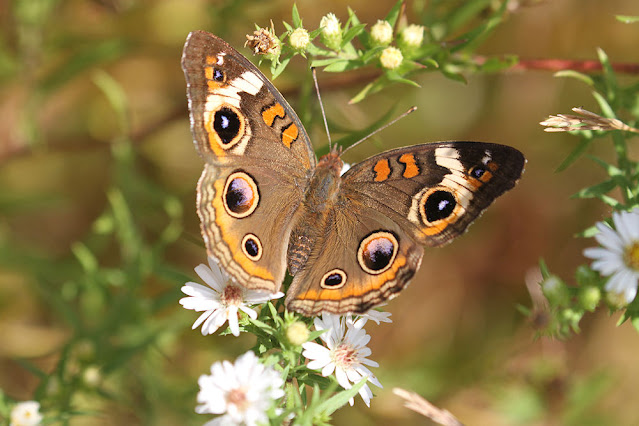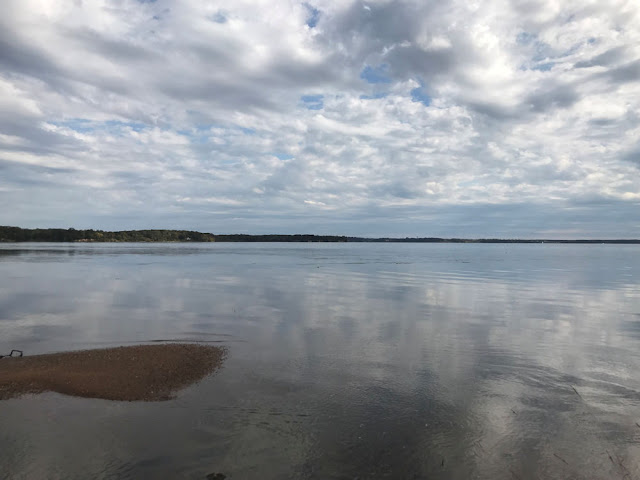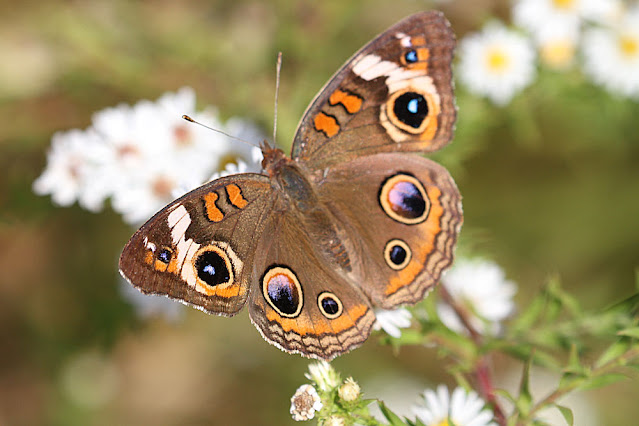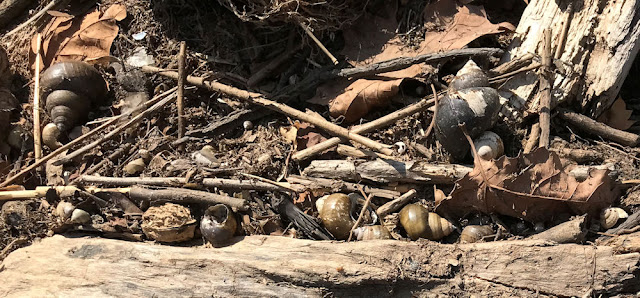
Gregg took photos of the pair.
 Named for its conspicuous target-shaped eyespots, the common buckeye, Junonia coenia Hübner, is one of the most distinctive and readily-identifiable North American butterflies.
Named for its conspicuous target-shaped eyespots, the common buckeye, Junonia coenia Hübner, is one of the most distinctive and readily-identifiable North American butterflies. 


These snails can close their shells with something akin to a trap door, and survive out of the water for as long as a month. The snails feed on the algae growing on the river bottom, yet they excrete very little of the pollutants phosphorus and ammonium. In their tissue the snails concentrate spilled oil and other toxins, a trait that makes them potentially valuable as tipsters on pollution. When water temperatures rise above 59 degrees, a female snail starts giving birth to quarter-inch-long juvenile snails, a hundred at a time. If pressured by predators she can reproduce at twice the normal rate.
Females live for about five years, males for three. They retreat to deep waters for the winter where they hibernate in the mud. They were introduced by merchants and sailors to the West Coast in the 1890s, for the Asian food markets. They are native to Burma, Thailand, South Vietnam, China, Korea, the Phillipines and Java. By 1911 the snails had escaped to California irrigation ditches.
Later they were introduced in at least 27 states, especially in the northeast and the Great Lakes region, and now can be found in the Potomac River. Demands for food, aquarium and water-garden markets helped distribute the snails across the country. By 1960 mystery snails had found a haven in the Potomac River at Alexandria.
More information than is needed I am sure for this blog post, but I wanted to add this as I find it fascinating and always want a record of everything that peaks my curiosity.
Sadly the beach along the river is littered with plastic bottles and other debris that is washed ashore from all over. I read on someone's blog that each time they visit this area, they take along a rubbish bag. I thought what a good idea! I know it seems that one person can't do much, but the next time we took a walk there I would like to bring along our own. To my mind every little helps and I would feel a whole lot better doing my small part.
So, that's it for today. I will be sharing Part 3 next time.
Thanks so much for visiting and I hope your day is a great one.










This snail info is fascinating! It is almost like science fiction, don't you think so? And how sad that this butterfly lives for such a short time!
ReplyDeleteI thought so too Ginny and it makes you wonder where people get their ideas for science fiction shows don't you think? Maybe from various things in the natural world? Yes, it is very sad, a short life but the beauty they bring us is never-ending. I will remember these butterflies thanks to my photos. And hopefully their short lives are like an adult's long one. Living in hope that it is :)
DeleteThe Mystery Snails are indeed fascinating. I didn't know that any snails gave birth to live young.
ReplyDeleteA big, big sigh at the litterers in our species. Thank you for you commitment to helping clean up after them.
Hi Sue, this was news to me also. Sighs heard all around the world. I will try to do my part in my own small way. Even a tiny drop in the ocean sends out ripples :)
DeleteNice and calm is that water and inviting to take a dip.
ReplyDeleteThe snails are amazing, the butterflies are always good to see and your text good to read. Thank you Denise.
Thank you Margaret, happy you enjoyed my post and you are so very welcome :)
DeleteSad about the beach and the litter. I don't understand how people can be like that.
ReplyDeleteThose butterflies are beautiful.
Yes Ann, maybe one day they will invent a material that will just dissolve into nothing. Maybe it's the science fiction I talked about earlier but living in hope here.
DeleteHello Dennise,:=) What a delightful post of two subjects I'm fascinated by. The butterfly is so beautiful, and it's a shame it doesn't fly to Portugal. At least I have seen many lovely photos of it on your post, and all the information about the snails was so interesting. If everyone thought like you. and took a plastic bag with them, this area would be cleared of rubbish, but one person can make a difference.Good for you!:=)
ReplyDeleteThank you for the kind words Breathtaking :) and am happy you found these subjects fascinating.
DeleteI have done the litter pick up myself...it's so disheartening. I think a lot of the beach litter we see is from the oil rig workers out at sea...but, that's just part of it. Those butterfly photos are supreme Denise! And the info on those snails so fascinating...like attending Biology class (a favorite subject in High School!! -it helped having one good looking, sexy teacher too...Mr. Wood ��)
ReplyDeleteI am applauding you for doing that Anni. So glad you enjoyed and found it interesting. Ah yes, I remember having a crush on my history teacher :)
DeleteThat Common Buckeye is stunning and fabulous photos. Why cannot people pick up their litter it makes me so angry to see rubbish in beautiful places, or in any place for that matter. It is so easy to carry it to where it should be dumped. We are lucky in France we have a great recycling system but even here there are people who are too lazy to follow this simple route. https://mylifeinthecharente2.blogspot.com/2019/03/recycling-in-charente.html
ReplyDeleteKeep safe Diane
Hello Diane, thank you :) and great recycling systems are to be admired. There are fines for littering but doesn't seem to be much of a deterrent in cases where we will never know where the litter came from in the first place.
DeleteHello, Denise
ReplyDeleteWhat a pretty place and trail, except for seeing the trash. The Butterflies are lovely captures and sightings. The snails are cool. Take care, enjoy your day!
Thank you Eileen, and you take care and enjoy your day also :)
DeleteThe butterflies and flowers photos are absolutely awesome!! So beautiful. And the info on the snail is really interesting to me and I did not know snails could get his big is 3 in. I would have been with you photographing the sales instead of going ahead if I find something that interest me I can't stop snapping
ReplyDeleteYou and I are very alike in multiple snapping things that interest us Sandra :) Thank you!
DeleteI think the litter pick-up thing is is a great idea and that we should all do it when we go anywhere like that just think what if only 50 people did it that would make a difference
ReplyDeleteYes, like a snowball speeding downhill, gathering momentum :)
DeleteLove your butterfly photos they are amazing!
ReplyDeleteThank you Christine :) I do too, I was in awe of those butterflies. Rarely get to see that kind.
DeleteThose butterflies are wonderful, fabulous photographs.
ReplyDeleteI do so wish people would just take their litter home and dispose of it sensibly.
All the best Jan
Thank you Jan :) and me too. All the best!
DeleteBeautiful butterflies.
ReplyDeleteThank you William :)
DeleteWow, your husbands photos of the buckeyes are extraordinary! The snails are interesting creatures. Their shells are so unique..Litter is such a problem. If we all pick up trash on our walks and hikes it would be great for our planet.
ReplyDeleteThank you Martha Ellen, he did a great job and is has an excellent eye for seeing things that I don't at times. He says we are a good balance. It certainly would be great for our planet wouldn't it?
DeleteIt was so good to see those Buckeye butterflies...normally I see a lot of them but did not see a single one this summer. I know that was because I was not out much. I think they are so beautiful.
ReplyDeleteI know what you mean, I felt lucky to see the Buckeyes as I had only seen them one other time this past summer. They are beautiful aren't they? Thank you Rose!
Delete